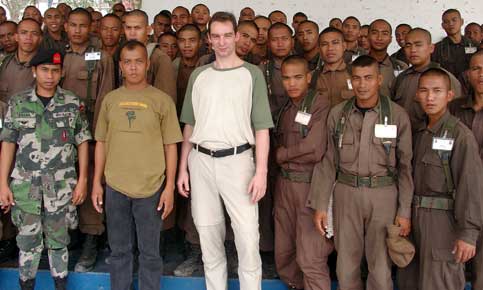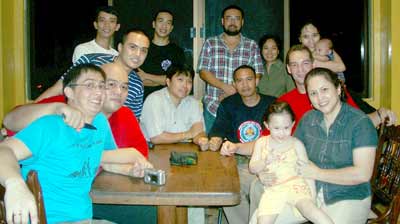The Power Break Blog
Five Minutes with Armadong Kali
Ideas = Inspirations = News = Thoughts
Five Minutes with Armadong Kali
Ideas = Inspirations = News = Thoughts
Exclusive Interview with Uli Weidle
Conducted by Marko Ronkainen for Potku.net
To mark the first Pekiti-Tirsia Kali workshop with Mandala Uli Weidle in Helsinki, Potku.net’s Marko Ronkainen spoke with him about his experiences and insights. Enjoy this exclusive pre-release of their conversation.
 Mandala Uli performing in dynamic Pekiti-Tirsia exhibition with Mandala Rommel Tortals Manila Pitbulls in Mega Mall, Manila, Philippines. |
Tell us something about your background and how did you get started with the martial arts?
I was born in 1966 in Reutlingen, a town in the south of Germany, near Stuttgart. At the age of 8 I started practising karate because I was being bullied by a bully twice my age. There was a new karate school in town and from what I had seen in the movies it seemed to provide the answers to my situation. To make a long story short, over the next few years I trained 3-5 times a week, progressed and won a few tournaments. As a two-time state champion, I found out the hard way that winning a tournament is not the same as successfully managing a street conflict. This experience opened my eyes and started my search for a martial art that teaches practical self-defence skills.
How did you get involved with the Filipino Martial Arts?
Looking back, my involvement with Filipino Martial Arts was no accident. I had practised a variety of martial arts including Muay Thai, Western Boxing and Ving Tsun, which I actually taught for a number of years. All the time I was looking for a practical self-defence method. Well, for any martial artist with a self-defence focus, the ultimate challenge is how to survive a knife attack. National and international martial arts magazines agreed that it was the Filipino martial art that offered the most practical answers to the questions raised in a knife culture. So, looking back, it was FMA that I was looking for all along. Although it's easy to see in retrospect, it took me many years to realise it.
When I first became interested in FMA, it was only to learn about the street reality of knife attacks - I had trained in some Chinese and Japanese arts that taught weapons in the advanced phase of training, but none of them really taught anything that I considered useful for the reality of the street. So I evaluated and tested many systems of FMA and when I finally found Pekiti-Tirsia in the USA, it was the first to meet my requirements. Little did I know that what was supposed to be a sideline would dramatically change my understanding of martial arts.
How do you see your evolution as a martial artist, if you consider what motivated you back then and motivates you now, what's different?
I kind of went back to the original motives that got me into martial arts in the first place. I kind of rediscovered them after I had forgotten about them, distracted by tournament sports and rankings - all those shiny fake goals.
What is different now is that I understand better what those original motives really meant - what self-defence really is and how it is necessarily linked to a lifestyle and a philosophy of life. Now that I understand that, I realise the true power of it and I don't want to lose it.
As a result of realising the power and value of the Pekiti-Tirsia Kali philosophy of life, which is to believe in life, good health and success, and to respect others who respect life, martial arts has become a positive force. Because of martial arts I am in the fortunate situation to live a life in good health, a happy life I can say, with good friends and to be able to concentrate on what I enjoy and really appreciate doing. With this life situation, helping others has become more important to me. Among other projects, with the support of the PTE teachers, I set up a sponsorship programme to help young students in the Philippines with their tuition fees, and to use this as a means of helping young Filipinos rediscover the values and worth of their own heritage before it is completely lost to Americanisation. It is a way for us to give back to the Filipinos.

How did you first meet Grand Tuhon Gaje and what was the impact of that meeting?
When I first started training in Pekiti-Tirsia, I learned from a first generation senior student of Grand Tuhon in the USA. I still remember my first meeting with him in New York, when I got my first hands-on experience of what the system was all about: We trained empty hands, stick and knife in all combinations. In empty hands I liked the system because it was all practical and yet different enough to surprise - it wasn't just the usual stuff that everyone expects and is prepared to neutralise and counter.
Powerful and very street smart, the empty hand alone was enough experience to make me study Pekiti-Tirsia with real interest. But the big surprise was in the knife: I thought my empty hand skills, especially Chi Sao, would give me a small chance against the knife - I was so wrong! That was the time when I realised how lucky I was that in the time before, when I sometimes had to deal with a conflict situation physically, no skilled person had ever pulled a knife on me.
I realised that Pekiti-Tirsia had become my primary art when I was about to demonstrate a specific counter technique of my previous art. It happened that my partner attacked me early and with much more power and intent than I had expected - I reacted spontaneously with a counter that clearly had a Kali flavour. Since then Pekiti-Tirsia has become my primary fighting art, which never let me down when the gloves are off and the game is on.
While teaching Pekiti-Tirsia to my students, I got the impression that something was missing and I seriously thought about adding this missing part. I talked about it with my instructor from the USA. It ended in a friendly game, after which he agreed that I should start developing extensions to the curriculum. It was about a year later that I met Grand Tuhon Gaje for the first time. It happened that Grand Tuhon started the very first training session with the material that I felt was missing in the curriculum of his senior student. This was without us having talked about the subject beforehand. Some of what he showed was identical to what I had developed so far and others were far more sophisticated than I had ever imagined. It was then that I understood that the Pekiti-Tirsia system as taught by Grand Tuhon Gaje offered everything I was looking for - it's there for me to discover, and more than that, the system already has all the answers, field and combat tested, before I'm even able to ask the questions.
Is Pekiti-Tirsia your full-time job or do you do something else as well?
What was a passion has become my life. I teach, train and promote Pekiti-Tirsia as a professional. It was not like that before. In the 80s I had an IT company and made a living from it. When the martial arts took up more and more of my time, I had to make a decision. In the mid 90's I decided to sell my company and live my dream now and not later.
What's you're view on this, it is often said that in order to be a skilled martial artist one has to practise, practise and practise. Does this mean that things like other career options and family will automatically have less time in life?
For people with a commitment and dedication to martial arts, it is natural for MA to influence all areas of life. This doesn't mean that all life should be MA. The natural order of priorities is family+friends, then business and then past times. For most, MA is a past time. For some it is a business, they choose to do it professionally. For a few, it is like being part of the family. That is the highest level of commitment. Having said that, I should add that no matter what importance martial arts has in your life, one of the lessons of martial arts is the importance of balance. If you focus in the wrong direction, you run the risk of losing your balance. The priorities form a triangle and the triangle is only complete when you have all three sides.
Filipino Martial Arts are quite popular in Germany, how many practitioners do you estimate there are in the whole country? How many Pekiti-Tirsia practitioners there are?
This is a difficult question to answer. In recent years there have been a growing number of people who, for various reasons, teach the FMA methods under different labels. Is this still FMA? According to figures I was given a few years ago by a martial arts friend who's interested in statistics, there should be about 4000 people involved in FMA. I never asked him how he counted the people. According to our membership records, we have about 300 people doing pure PT. Having said that, it should be added that for us "how many" is a question of secondary importance. I am more interested in 'how well'. That is one of the first things I learned from GT.
You yourself spend a lot of time travelling in the Philippines and other countries, do you have many instructors besides yourself that train people when you're not there yourself?
In my local club we currently have seven instructors, including myself. There are six men and one woman. When I am in town, most of the training is done by me personally. Some of the guys have now started their own groups in neighbouring towns. I support them in any way I can.

How did Pekiti-Tirsia Europe get started and how has it grown since that?
I started practising PT in the early 90s, learning in the USA and then training with some friends in Germany. In 1996 Grand Tuhon sent me on a mission to formally organise PT in Europe. At that time he gave me guidelines on what to do and what not to do. He didn't want us to bastardize the art by mixing it with other arts or to commercialise it by teaching forms or sets of techniques, that would only distract the student from what is needed to develop skills and experience.He wanted to start the Pekiti-Tirsia in Europe on a higher level. No waste of time - all functional training based on trust, to show the core and essence of the PT system complete with its philosophy, to build a fighting force and friendship across the borders of countries.
We started as a committed group of friends and now have representatives in many European countries. The bonds of friendship are still what hold the group together. This is the quality we want to maintain. It is a quality necessary to really train the art.
You've organized Pekiti-Tirsia festivals in Reutlingen, please tell us more about them
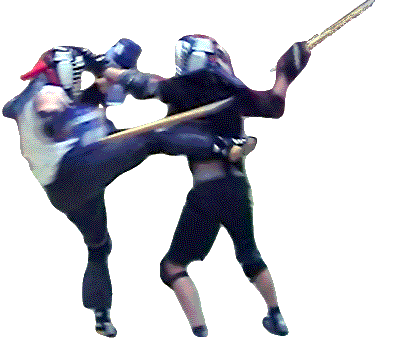 Swedish and German Pekiti-Tirsia Fighters in a C-Level Fighter League Stickmatch at Kali Festival 2003 in Reutlingen |
We usually make it a two day event. The first day is for fighters only, everyone can experience fighting and the atmosphere is great. There is no need for rules and there is no unnecessary hardship as there is nothing to win or lose but experience and friendship. The second day is an open day for everyone with all the excitement of demos and fights, free food and free entry.
There's also a big FMA event in Dortmund bi-annually (I think), have you taken part in that and will you in the future?
When Alfred Plath invited me to the first one, I think it was in 2003, I accepted immediately because I liked the idea of promoting the values and diversity of the FMA. In order to support this event, I agreed to teach there without any payment, only travel expenses. Unfortunately, I came down with a high fever and was unable to travel. I am still sad about this, because I know from feedback on the internet that a good number of people went there because they wanted to meet me and experience PT. To those who contacted me, I offered to attend one of my seminars free of charge.
For the second event Alfred invited me again and I agreed to support the event and teach again for free - but I didn't like the format of very short sessions of less than an hour. The participants would practise a lot of systems, but only scratch the surface, never really getting into it or feeling the different subtleties that make up the systems. The student will leave the workshop with the impression that FMA systems are just a random collection of techniques and drills. This would be an injustice to all the FMA systems, which have a valid identity of their own. I discussed this with Alfred and we agreed that I would teach 2 sessions of 2 hours each instead of the suggested 4 sessions of less than 1 hour each. Shortly before the festival Alfred called me and told me that Dieter Knüttel was not willing to accept this agreement. According to Alfred, Dieter insisted that I do 4 times 1 hour, no other option. I declined.
How much co-operation you generally have with other FMA organizations in Germany and Europe? What about other martial arts?
Pekiti-Tirsia attracts experienced martial artists from many styles. Boxing, Muay Thai, various Silat styles, MMA, Taekwondo, Karate, Judo, other FMA, sport fencing, Capoeira, reenactment swordplay,... you name it.These people have their friends and contacts and this naturally becomes part of the Pekiti-Tirsia friendship network. This is not organised or written down in any way - just friends of friends, because friends will be friends. According to the PT philosophy we believe in making friends not enemies.
What about Pekiti-Tirsia globally, naturally it's popular in USA (like everything seems to be), but how about the rest of the world?
There is a high demand for Pekiti-Tirsia in many places but we don't have enough instructors to meet all these requests. I have several pending invitations from Austria, Spain, France outside Europe in India, Dom.Rep even from places in Philippines, Thailand and Indonesia asking me to teach there. These requests are on hold as I don't want to divide my attention too much between too many places. I still follow what GT told me in the early days: Quality first! I am already travelling three out of four weekends to support the various Pekiti-Tirsia groups and there are still so many open invitations. As you can see we have a demand for good instructors. But we don't want to sacrifice quality for quantity. That is why we have the Instructor Candidate Programme in Europe and the Philippines.
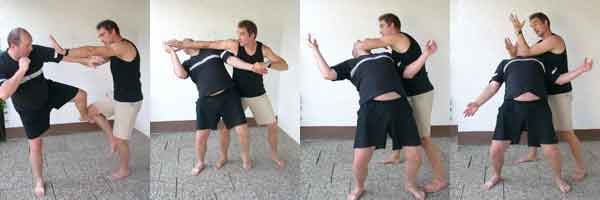 Pic1: Uli is attacked with roundhouse low-kick. He uses the force of the incoming kick to destroy the attacking leg with a counter-knee-attack to the ankle/in-step. At the same time Uli shields and monitors incoming Jab-Cross Combo. Pic2: Stepping down Uli uses Banga-principle to break the attackers balance and body structure using simultaneous leverage against neck, shoulder, elbow and hip. Pic3+4: Finishing off with loaded elbow attacks. |
A little bit about Pekiti-Tirsia itself, then. What makes it different from other martial arts and especially other Filipino Martial Arts?
First of all, I should ask back, distinct from what other martial arts? And then, to answer your question, it would still require a library of books - and that's exactly what we don't want. But anyway, for your satisfaction here are some of the main ideas of the system: Pekiti-Tirsia is a training system that produces good habits of thought, body mechanics and awareness. The whole system is based on the principle of movement, adaptability and higher understanding. It is not based on techniques or drills. Pekiti-Tirsia is taught by experience and taught to produce experience. Geometrically the system is based on triangles and circles, as can be observed in nature with shark teeth and the movements of the stars in the sky. We use no blocks, no static stances, but direct counterattacks and offensive deflections. We don't teach the student by associating words, but by using a thought-provoking process. That's why we don't want books or videos about PT. Our philosophy and fighting methods are those of a blade culture, our weapons are whatever is available to us.
Do you see it as evolving art (testing & applying new techniques, cross-training on other martial arts) and how has it evolved during your time? Or is it more a traditional art that has certain repository of techniques and the will to keep it as such by not changing anything?
Pekiti-Tirsia is by tradition an evolving art. This is because of our teaching method. And this is what makes Pekiti-Tirsia a truly indigenous Filipino art. Grand Tuhon told me that in the old universities, before the Spanish came and replaced, or rather destroyed most of the indigenous Filipino culture, there was a different school system. The teacher was not there to give answers and test if the student had memorised well. Instead the teacher was the one who asked questions and then helped the student to find valid and maybe new answers. This is still the way for Pekiti-Tirsia: each generation of practitioners does not copy the master by blindly following his way, but a new practitioner rediscovers the logic of the system in a way through his own logic and experience, guided by the experience of the teacher. In this way the system is revalidated by each new generation of practitioners. By following tradition, the Pekiti-Tirsia system is always valid and up to date.
As a result, Pekiti-Tirsia was chosen as the official martial art of the PMC (Pilipino Marines Corps). Since 1998 I have been involved in the training of the Force Recon, the most prestigious commando unit of the Marines. We also train the SAF (Special Action Force), the CRG (Crisis Response Group) and other special units of the Philippine National Police. We are involved in training many of the elite military and police forces in the USA and Europe. Of course, the Pekiti-Tirsia system is always tested in the field. In other words, Pekiti-Tirsia is constantly quality controlled in the real world laboratory. We evaluate mission results and if there should be a need to improve PT, we are the first to be interested in discovering it.
Mandala Uli with Cpt Cautiver and Special Action Force (SAF) Commando from Philippine National Police (PNP) |
In the past, Filipino masters were very selective about their students and also very protective of their art, for example not allowing their students to train with other masters. Has this changed and what is the situation today?
In short, it has not changed, but there is an additional layer of easily accessible commercial FMA on top of what has always been there, usually accompanied by the adaptation of commercially successful marketing concepts from Japanese and Korean martial arts, such as katas, belt rankings, uniforms, standardised group instruction and, most importantly, teaching by word association.
Beneath the commercial surface, there are still some people in the Philippines who have a knowledge and vast experience that can only be described as martial arts treasures. Such people like Manong Kolimbo or Manong Basko, I have met some of them in the most unlikely places, and in fact I have been found by these men more often than I have found them. They usually like to keep a low profile, avoiding challenges and maintaining the element of surprise in case they need to rely on their skills.
In all times, present and past, what was used to fight for real was always kept as protected knowledge, hidden within the family circle, as a natural by-product of the fact that life and the skills used to protect that life were, and still are, a treasured possession. "Take your best strike" - this is a common challenge. Why should anyone reveal their "best strike" to someone they cannot trust?
Let me give you an example: Manong Olavides of the Uno-Dos-Tres DeCampo JDC once told me how Grand Master Cabaleiro used to teach. Many people wanted to learn his skills. They would pay with chocolate or other favours, sometimes with money, for GMCabaleiro to show them a trick or a move. He would not really explain the finer points and would not really correct the student if they were doing it wrong. If the student was beaten in a fight and complained, the Grand Master would ask how and with what strike the student was beaten, and then he would show the counter or correct the problem in the movement - in return for more chocolate, of course. Manong Olavides learned this way for many years, and it wasn't until Manong Olavides selflessly helped Grand Master Cabaleiro with a serious family matter that Grand Master Cabaleiro was convinced that Manong Olavides was a good person to trust. It was then that Grand Master Cabaleiro began to develop an interest in teaching Manong Olavides the full skill, showing him the finer movements, correcting the subtleties and making sure that he really understood.
Although FMA instruction is widely available commercially, only instruction based on trust and a personal relationship means a genuine interest in teaching the person to the best of their ability. This was true in the last generation and is still true today.
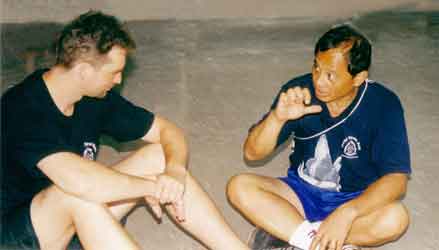
Grand Tuhon Gaje is a living legend among Filipino masters and martial artists in general. What makes training under him so special?
If this question could be answered so easily, then everyone could have the quality of Grand Tuhon and become a living legend like him, but I will give it a try and answer you based on my personal experience.
One of the many qualities that make Grand Tuhon such an unparalleled trainer is that he not only teaches physical skills, but he develops the whole personality of the student. According to the Pekiti-Tirsia philosophy, we believe that every person has potential, ability and skills for success. Yet most people don't even come close to exploring this potential because they are afraid of failure and choose to live a boring, unchallenging life in their own little cage of security. One of Grand Tuhon's favourite quotes: "The worst thing that can happen is when nothing happens at all."
In short, what makes GT special is that he lives Pekiti-Tirsia, that he truly is Pekiti-Tirsia. To know that man is an experience that really touches a person and inspires people to grow, to explore their potential, to do great things. That's really what makes Pekiti-Tirsia so valuable. It is really more than techniques.
How would characterize him as a person?
He is unique. An original that many try to copy and by doing so they miss the essence. His humour is special, it is based on a logic that can only be described as Tuhon logic. His humour is his best teaching tool. His dedication to the Filipino Martial Arts and especially to Pekiti-Tirsia is the strongest force. It can only be understood if you know the man. He expects the highest level of dedication and loyalty, but he never demands it. In the beginning I was often confused as to why he never used his authority to command and rule over others, to make things easy by instilling strong discipline. In time I understood better: What is true, it can not be asked for. If the person has got the message, then it comes naturally. If the person hasn't got the message, it will never be true anyway. So why ask for it?
Manila Pitbulls with Mandala Rommel Tortal and Jasper De Ocampo arrange a have–a–good–trip–and–come–back–real–soon party for Mandala Uli |
You yourself travel to the Philippines at least once a year for lengthy periods of time for advancement training. How do you see yourself changing during these periods?
How have I changed? Better ask others about that, not me :)
From the reactions of my friends I can tell that in the beginning, when I returned from the Philippines, my long-time students were suddenly afraid to train with me. This was not because I would hurt them physically, but they sensed a change in me, probably something to do with commitment. It could be described as a growing inner strength that comes with the experience of better understanding. Another change: I smile more often.
How does the training in Philippines differ from the training in Europe?
There are differences in climate that allow and require different training structures. But more importantly, Filipinos and Westerners typically have a different temperament and a different mind-body relationship. The training has to take this into account. Pekiti-Tirsia training develops a skill based on balance, the balance between mind, body and awareness. The effect of this balance can be described as a spontaneous understanding. The result of this understanding is that what used to be reaction becomes spontaneous action and counter-to-attack becomes immediate counter-attack.
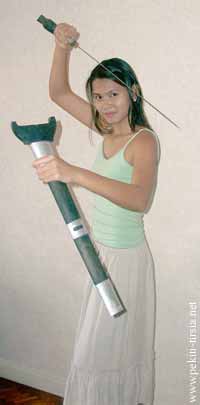 How would you describe the Philippines as a country and the Filipino as a people? How does this affect Filipino Martial Arts and training of them?
How would you describe the Philippines as a country and the Filipino as a people? How does this affect Filipino Martial Arts and training of them?
The Filipinos are a special people who live a mixture of Asian and Western thought and belief - a mixture that has evolved over generations. Life there is appreciated, felt and spontaneously expressed with a burning intensity and consequence that is unusual for Western people. This Filipino spirit is what makes Filipino martial arts so special and effective.
How does this affect training? As I explained in my last answer, training Pekiti-Tirsia means developing a balance and this balance is generated from the fire of enjoying and appreciating the bare essentials of life. In other words, training FMA the right way awakens the Filipino spirit in the European.
Now that Finland has had it's first official seminar from Pekiti-Tirsia Europe, please comment that a little, and give us some tips what to work on especially before we see you next time.
Looking back on the seminar, I would say that I really enjoyed training with all of you and I was impressed that everyone trained up to the very last minute. There was not one weak spirit in the group - that is special for a first seminar. My compliments to the Finns.
What to practise? I showed that in the workshop. Develop good habits, good body mechanics. Make sure that the basics are functional and make sure that you train with an open mind, guided by honesty, friendship and respect: looking for answers and helping each other to find the questions that will lead us there.
Jussi and Jarkko were perfect hosts who added to my good experience in Finland. I am looking forward to return to Helsinki and I will be happy to meet the same group. If you guys support each other then you will have my support and for sure we can start a quality Pekiti-Tirsia in Finland. In May 2005 I will be with Grand Tuhon Gaje in Sweden and if the Finns continue the way they started it won't be long and we will have Grand Tuhon coming with me to Finland.
Till Then,
Burning Sticks!

Group photo from the Helsinki Pekiti-Tirsia Seminar 2005
Thank you for the interview, Grand Tuhon Gaje will be conducting a seminar in Stockholm in May, hopefully we will see you in Finland again soon and maybe one day Grand Tuhon himself!
